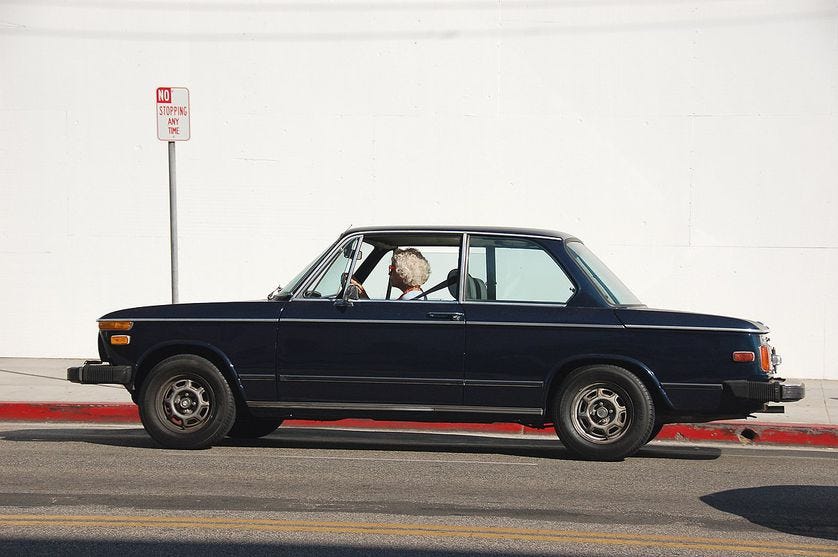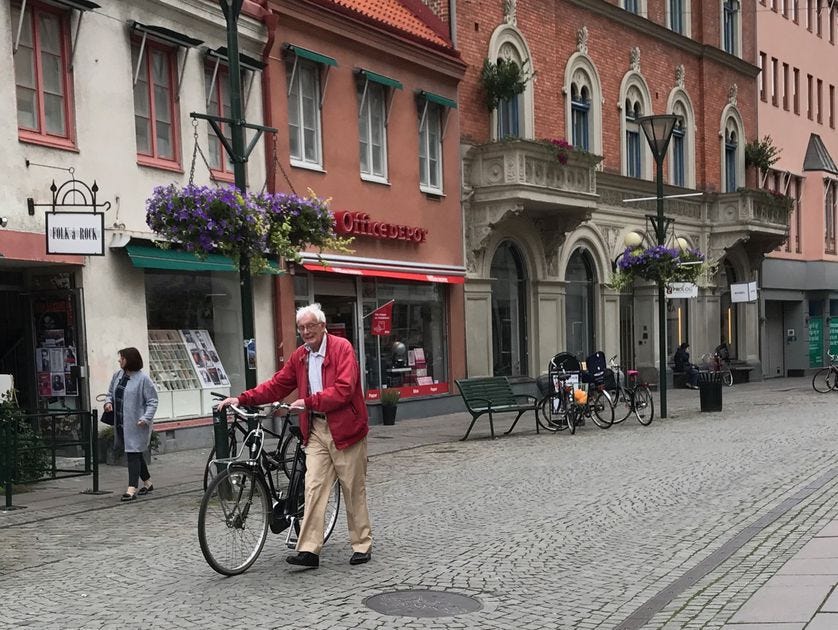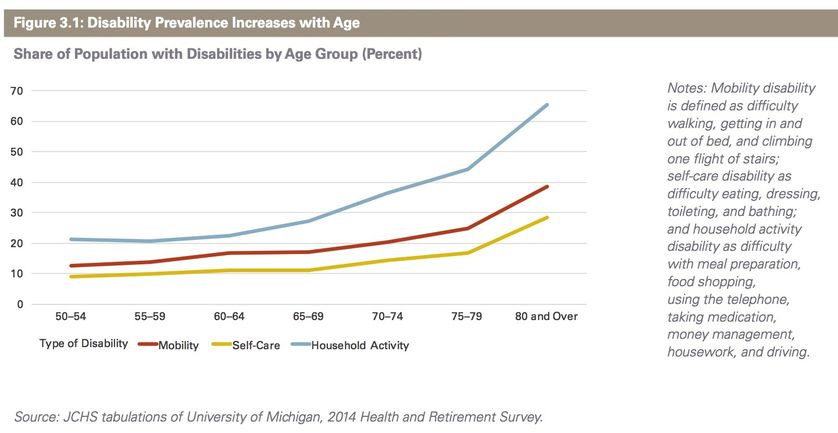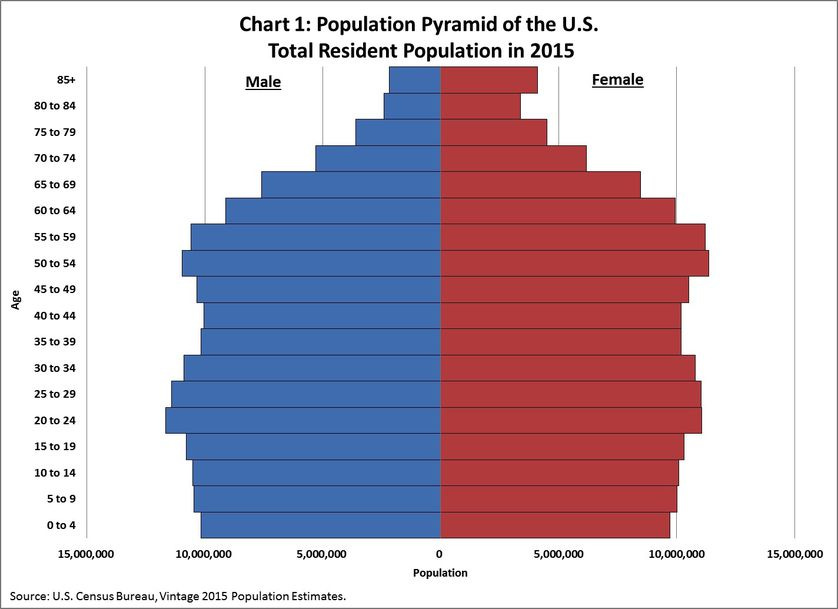From the archives, when the demographic time bomb was still a few years away
I have been complaining for years that we are not ready for this. Here are some of my earlier predictions.
My recent post, The demographic time bomb is about to detonate, sparked a lot of discussion and interest. It is a subject I have been thinking about for many years, and wrote about often on the now-defunct Mother Nature Network. I was revisiting my archive of disappeared posts and thought readers might find them interesting. Here is one of my earliest, from 2017; I follow with two that were controversial at the time.
The big wave of aging baby boomers is coming.
The question is, will the world be ready?
January 30, 2017
Writing in the New York Times, Allison Arieff picks up on a theme we've been covering on MNN: how aging boomers will live after they hang up their car keys. She describes taking the keys from an elderly relative: “Don’t take my car away,” he pleaded. “Without my car I don’t have a life.”
He plans on staying in his suburban home, “even if that home is slowly becoming a dangerous place for him to be in.” Allison does’t say how old her elderly relative is, but I suspect he's not a baby boomer, born between 1946 and 1964, and topping out now at 71. This is an important distinction for a number of reasons; Allison is describing the problems faced by seniors now, and she's extrapolating it to the younger baby boomer cohort, noting that 10,000 of them are reaching the important age of 65 every day. Allison is surprised that the market is not really being addressed by the housing industry, writing:
Thoughtfully designed housing for older adults is not being created on a scale commensurate with the growing need. It’s not a market many architects or developers have embraced. Conversely, a disproportionate amount of attention has been focused on the presumed desires of millennials. We hear all the time that it’s that group that craves walkability, good transit and everything-at-their-doorstep amenities — and that only cities can provide it.
There are a number of reasons for that: most of the people who do marketing are young. Doing stuff for old people isn’t fun. One marketing consultant who founded the Boomer Project noted:
It's as if marketers all wear the same blinders. Because so many marketing executives are under 40 — or even under 30 — many presume most consumers not only think like them, but want to be like them....Most marketing that targets Boomers presumes there's something wrong with them that needs fixing, such as age spots, wrinkles or erectile dysfunction. It's malady-based. For the most part, it's not accurate."
Sure, things will go wrong, but not in the order you think
So when the companies do think about designing for those growing older, their thinking is malady-based too; even Allison lists what could be considered malady-based design issues like “step-free entrances, single-floor living, under-counter appliances, and halls and doorways that accommodate wheelchairs.”
But as we noted in our post about what kind of housing do aging boomers need,these mobility-based problems are the last to hit us; the first are household-based activities like driving, food shopping, taking medication and meal prep. These start hitting in significant numbers in the mid 70s, and the boomers aren't there yet.
These are also problems that are solved by community — being able to walk to shop, cheap restaurants where one can get prepared food, neighbors who might look in and check if you're taking your medication.
Right now, boomers feel pretty good
The fact is that right now, most of the baby boomer cohort is still pretty healthy. According to a Del Webb study, they all feel a lot younger than they are, and until the health problems start hitting them, they will think they are much younger. So it should be no surprise that there are not too many of them worrying right now about giving up their cars; they all think they're fine.
Allison concludes:
Every day for the next 19 years, 10,000 people will reach age 65. That companies aren’t scrambling to exploit this market is not only unfortunate for their bottom line, but almost certainly treacherous, eventually, for all of us.
Oh, but the companies are indeed going after this market. I believe that Allison is making the dangerous mistake of conflating seniors with their kids, the baby boom generation.
The power of boomers
Baby boomers buy 60 percent of packaged goods, spend 75 percent more on vacations, and buy half of all new cars. They own a third of all the iPhones and half of the Macs. Baby boomers, because they get out and vote in higher numbers, just elected the new American government and pretty much control it. President Trump is 70, Wilbur Ross (Trump's nominee for secretary of commerce) is 79, and the average age of the cabinet is 62. The baby boomers own America, and now they rule it.
Allison alludes to some of the alternative forms of housing, like co-housing and communes — and don't forget baugruppen. She also mentions NORCs (naturally occurring retirement communities). I've gone on about the importance of living in walkable communities with those things that Allison says the millennials want, such as good transit and everything-at-their-doorstep amenities. We both agree that people have to start thinking seriously about these issues, but most baby boomers simply haven’t yet. Most who have decent jobs aren't seeing that retirement barrier at age 65 either.
Allison also describes how technology can be part of the solution, with Uber, home delivery, apps and wearables. She notes that “Summoning these cars is a no-brainer for heavy users of smartphones, but for older people with declining vision and motor skills, it’s a puzzle.” But not for us baby boomers; we just upgrade to the iPhone 7 Plus and get a bigger screen. (I did, and it works!) Again, she's conflating seniors with tech-savvy boomers who have fine, well-practiced index finger skills, along with Siri and Alexa.
In fact, I think the biggest problem for boomers might well be over-reliance on technology. My late mother-in-law spent her last years parked in front of the television, with only the 50 channels the cable company gave her. Now we can get endless streaming of Netflix and every other service to fill our time. Soon we all might be wearing Oculus headsets and never leaving our chairs.
Everyone is talking about George Orwell’s "1984" right now, but perhaps a better analogy of where we're going is Aldous Huxley’s "Brave New World," with its Soma, the drug for “dulling the senses against any perception of the emptiness of life” and its feelies, films so real that you get smells and touch as well as sight and sound.
That's what happens when people are trapped in their homes, or when they lose their car keys. Which is why we have to think community first, interior design second. And in the end, we're talking about timing. The baby boomer demographic bulge is just getting into its senior years. As one senior living expert, Bob Kramer, noted in an article Allison pointed to:
“Some of this is like surfing — you have to time the wave,” Kramer says. “You paddle too soon, and you wipe out spectacularly.”
The oldest boomers are just 71 now. But they're the leading edge with many, many millions to follow. We are 10 years away from the real crisis here. The question is, do we fix our cities and towns now so that they're ready for this wave, or will it drown us all?
In 2019, when I wrote this post, over 20% of the Japanese population was over 70, which we will hit in 2029. Many young people in Japan resented the older generation, and had a word for it: Rougai. I tried to imagine how young people might react to aging baby boomers in 2029. A lot of people were offended by this post, calling it “unbalanced and stereotyped,” and I had to follow it up with a sort of apology, but I still think it raises important issues and is worth republishing here, followed by the apology.
What will happen when 20 percent of the population is over 65?
In Japan, they call it 'rougai.' In North America, it will be much worse.

April 30, 2019
For the last few years, boomers have been complaining about young people walking slowly or erratically while glued to their phones. Young people can cheer up. In a few years, today’s millennials and Gen Xers will be the ones complaining about many of the 70 million aging baby boomers walking slowly or erratically and getting in their way. The oldest boomers are now 72 years old, and in about a decade, they'll be getting seriously old — 10,000 of them every day.
Imagine — untold millions of them, clogging the exits of the subways, blocking sidewalks and bike lanes with their walkers and mobility devices. Millions of drivers like my late mom, who would drive slowly down the middle of two lanes because it scared her when people passed her.
That's what's happening in Japan right now, where a fifth of the population is over 70 years old. Young people have a word for it, rougai, which some define as "the harm inflicted on Japan by its elderly." There are dozens of YouTube videos of old people jamming subway doors open, shoplifting and causing trouble. It sounds awful, but this is a thing there now. According to Leo Lewis in a paywalled article in the Financial Times,
Rougai, in the various mouths of its users, can be the stubborn idiocy of a senior executive who cannot use a computer but decries younger staff as inferior to previous generations. It is shoplifting sprees by retirees. It is superannuated politicians. It is elderly women hectoring young mothers in the street with unsolicited child-rearing advice. It is a snaking queue of septuagenarians dithering over touchscreen ticket machines. It is 90-year-olds causing pile-ups by driving their cars the wrong way up motorways.
I will shamefully admit to having occasional feelings of rougai in the bank, when some old person is taking an hour to pay all their bills at the teller window, or in the parking lot when someone is taking forever to park their car, or in the road, where so many drive like my mom and dad did.
Lewis notes that "generational friction is nothing new to humanity, nor special to Japan, but rougai seems to reflect a Japan-specific feeling that the young are being outnumbered by the old."
Meanwhile, in 2029...
Imagine 10 years from now in 2029, when North America is like that. When the youngest baby boomers turn 65, it will mean that for the first time, people over 65 will comprise a whopping 20 percent of the population. (Imagine, a fifth of the nation telling you to get off their lawn.)
If they're having these kinds of problems in Japan — where there's a strong tradition of respect for the elderly and a social safety net — what's going to happen in North America if we don't start planning for this inevitable demographic shift? Still focused on Japan, Lewis concludes:
There is no doubt that the country’s demographics will confront its society with an ever more irritating, complex and saddening list of problems. The burden of this will be immense and will surely fall most heavily on the generation that has shared and bemoaned the footage of the Nagoya door-stopper. They know what trouble is coming; at least they have granted themselves the empowerment that comes with giving it a name.
The crisis we face in North America is likely going to be far worse, and there's going to be rougai everywhere. We don't have the transit, the housing, and in many cities we don't even have sidewalks. We have a much higher proportion of women who work and aren't around to take care of parents. So far, the only answer anyone seems able to come up with is self-driving cars, but we're going to have to do a lot better, and a lot more, than that.
The apology tour:
What happens when 'Young-Old' baby boomers become 'Old-Old'?

A number of people were not impressed with my recent post, What will happen when 20% of the population is over 65? One person wrote that it was offensive, "It's so unbalanced and stereotyped, it's mind boggling that you would include it. Are you on a mission to help accelerate discrimination against older people?"
Actually, the intent was the exact opposite. In that post and in most of the posts I write, I'm trying to focus attention on the demographic issue of what happens in about 10 years, when the baby boomers start hitting their 80s in serious numbers, and was trying to use the example of what's happening in Japan now as a way of anticipating what might happen in North America.
In 1968, Simon and Garfunkel released the "Bookends" album with the song "Old Friends" which includes the lines:
Can you imagine us years from today,
Sharing a park bench quietly
How terribly strange to be seventy ...
A lot has changed. Today's baby boomers are healthier and more active than ever, and most who are over 65 cannot even really be considered "old." They certainly aren't sitting on park benches quietly. I'm one of them at 66, so I'm certainly not on a mission to discriminate against my generation. Some have said we're in an extended middle age. Personally, I'm hoping this stage lasts a long time, but time is still against us. Camilla Cavendish writes in the paywalled Financial Times:
"The 'Young-Old' are very active and healthy and productive — totally different from 30 years ago," says Professor Takao Suzuki, professor of gerontology at Tokyo's JF Oberlin University, who defines Young-Old as 60 to 75 — or older. "The World Health Organization defines 'old' as 65: but as gerontologists, our main concern is with the 'Old-Old', who are very different".
The Old-Old have very different needs from the Young-Old, and soon there are going to be a lot of them. My point in the post is that we have to get ready for that moment, and the time to start doing this is now, not 10 years from now.
I suspect the paragraph in my post that was considered offensive was the second one, where I imagine "untold millions of them [baby boomers], clogging the exits of the subways, blocking sidewalks and bike lanes with their walkers and mobility devices. Millions of drivers like my late mom, who would drive slowly down the middle of two lanes because it scared her when people passed her."
This was, in fact, a recognition of the reality that our transit systems need more escalators and elevators, that our sidewalks need widening, and that we need alternatives to cars for the vast numbers of Old-Old people in the USA in 10 years.
We still have a chance to get ahead of this
The post was meant as a warning that we could end up like Japan, where many young people apparently have come to resent the old people around them — in a nation where they usually get respect — and that to avoid this, we have to deal with the problems the old-old will face.
It's not just the in the sidewalks and subways, either; the Old-Old are going to have trouble finding places to live. A recent study published in Health Affairs notes that middle-income older people, without enough money for private seniors housing, but too much to qualify for low income, will have real problems.
We project that by 2029 there will be 14.4 million middle-income seniors, 60 percent of whom will have mobility limitations and 20 percent of whom will have high health care and functional needs. While many of these seniors will likely need the level of care provided in seniors housing, we project that 54 percent of seniors will not have sufficient financial resources to pay for it.
That's fully half the Old-Old population. This is what I've been writing about in posts like We're facing a demographic time bomb. This is my concern, trying to get people to worry about this issue of what life will be like when there are as many as 60 million baby boomers who are Old-Old.
So again, I want to apologize, I didn't mean to offend. I meant to draw attention to the reality of 2029, which is closer than we think.
Special offer!
I do not want to put up a paywall on this site, but it provides a meaningful portion of my income. So here’s a limited-time offer: I will send a signed copy of the print edition of “Living the 1.5 Lifestyle” to anyone in the USA or Canada who signs up for a one-year subscription (C$50, cheap at about US$35 ).








This morning I’m really really fed up with hearing how everything is the fault of Boomers - plenty of younger people showed up for Trump and drank the kool aid while some of us have been fighting our whole 70 plus years against Trumpist thinking under various labels. Boomers have certainly fallen short on our responsibility for the planet and its peoples but we didn’t fail alone. Vent over. We now return you to your ongoing apocalypse. Stay safe.
There are a number of initiatives in place in other countries, but they do take government investment. These can allow people to "age in place," which can be more cost effective than prematurely going into care facilities. In all of these countries, average lifespan is several years longer than it is in the US, and the provision of services for the aged improves quality of life in the declining years.
Where i am these initiatives range from affordable cleaning and gardening services, care visits, social assistance, meal delivery services, community transport, which can include regular outings for shopping, physical activity (eg swimming, attended by exercise physiologists trained to work with the elderly) and social activities, seniors activity centres, and integrated health care plans which include free visits to allied health care professionals. These services are subsidised, although many include a small co-payment, which is usually means tested and may be waived in cases of financial hardship.
We are going to have to increase our expenditure on these kind of initiatives as our population ages, and this is somethingthat does get attention from policy-makers. We also rely on immigrant workers to provide many of the services. This is factored into immigration policy. From a budgetary and Immigration perspective, the US looks to be heading in a direction that is diametrically opposed to where it needs to be going.